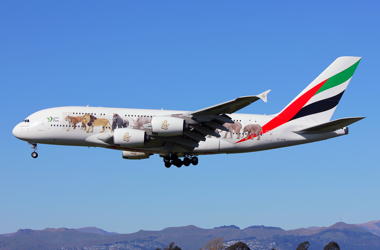Background Information.
In mid-1988 Airbus engineers led by Jean Roeder had begun work in secret on the development of an ultra-high-capacity airliner (UHCA), both to complete its own range of products and to break the dominance that Boeing had enjoyed in this market segment since the early 1970s with its Boeing 747 airliner. McDonnell Douglas had unsuccessfully offered its double-deck MD-12 concept for sale, while Lockheed was exploring the possibility of a Very Large Subsonic Transport.
Roeder was given approval for further evaluations of the UHCA after a formal presentation to the Airbus President and CEO in June 1990. The project was announced at the 1990 Farnborough Airshow. It had the stated goal of 15% lower operating costs than the Boeing 747-400.
Airbus organised four teams of designers, one from each of its partners (Aerospatiale, British Aerospace, Deutsche Aerospace AG and CASA) to propose new technologies for its future aircraft designs. These designs were presented in 1992 and the most competitive designs were used.
In January 1993, Boeing and several companies in the Airbus consortium started a joint feasibility study of a Very Large Commercial Transport (VLCT), aiming to form a partnership to share the limited market.
In June 1994, Airbus announced its plan to develop its own very large airliner, designated as the ‘A3XX’. Airbus considered several designs, including an unusual side-by-side combination of two fuselages from its A340, the largest Airbus jet at the time. The ‘A3XX’ was pitted against the VLCT study and Boeing's own ‘New Large Aircraft’, the successor to the 747.
In July 1995 the joint study with Boeing was abandoned, as Boeing's interest had declined due to an analysis that such a product was unlikely to recover the projected $15 billion development cost. Despite the fact that only two airlines had expressed public interest in purchasing such a plane, Airbus was already pursuing its own large-plane project. Analysts suggested that Boeing would instead pursue stretching the Boeing 747 design, and that air travel was already moving away from the standard ‘hub-and-spoke’ system that consolidated traffic into large planes, and toward more non-stop routes that could be served by smaller aircraft.From 1997 to 2000, as the 1997 Asian financial crisis darkened the market outlook, Airbus refined its design, targeting a 15 - 20% reduction in operating costs over the existing Boeing 747-400. The ‘A3XX’ design converged on a double-decker layout that provided more passenger volume than a traditional single-deck design. Airbus did so in line with traditional hub-and-spoke theory, as opposed to the ‘point-to-point’ theory with the Boeing 777, after conducting an extensive market analysis using over 200 focus groups.
Although early marketing of the huge double-deck cross-section touted the possibility of duty-free shops, restaurant-like dining, gyms, casinos and beauty parlours on board, the realities of airline economics have kept such dreams grounded.
On December 19, 2000, the newly restructured Airbus supervisory board voted to launch a Euros 9.5 billion ($10.7 billion) project to build the ‘A3XX’, re-designated as the Airbus A380, with 50 firm orders from six launch customers. The ‘A380’ designation was a break from previous Airbus families, which had progressed sequentially from A300 to A340.
It was chosen because the number ‘8’ resembles the double-deck cross section, and is a ‘lucky number’ in some Asian countries where the aircraft was being marketed. The aircraft configuration was finalised in early 2001, and manufacturing of the first A380 wing-box component was started on January 23, 2002. The development cost of the A380 had grown to Euros 11–14 billion when the first aircraft was completed.
